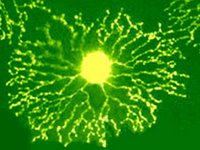Separate phases for encoding and retrieval in theta rhythms
 Several recent posts have highlighted the importance of the theta rhythm, including the idea that it may reset its phase according to stimuli in the external world, and that it may be particularly important for things like spatial learning, known to take place in hippocampus. In a 2002 issue of Neural Computation, Hasselmo and colleagues present a neural network model in which the theta rhythm's phases are broken up into separate functional parts. Specifically, at the peak of the theta wave, synaptic output ("retrieval" - specifically, region CA3) is weak and synaptic input ("encoding" - from entorhinal cortex) is relatively strong. At the trough of the theta rhythm, this pattern reverses itself.
Several recent posts have highlighted the importance of the theta rhythm, including the idea that it may reset its phase according to stimuli in the external world, and that it may be particularly important for things like spatial learning, known to take place in hippocampus. In a 2002 issue of Neural Computation, Hasselmo and colleagues present a neural network model in which the theta rhythm's phases are broken up into separate functional parts. Specifically, at the peak of the theta wave, synaptic output ("retrieval" - specifically, region CA3) is weak and synaptic input ("encoding" - from entorhinal cortex) is relatively strong. At the trough of the theta rhythm, this pattern reverses itself.Although these phase-locked patterns of activity may be unfamiliar to many, each has been identified to occur in a series of behavioral experiemtns in the 90's (referenced in Hasselmo et al.) It appears that the hippocampal theta rhythm is paced by input from medial septum, via the fornix, and theta activity can be suppressed by destroying this pathway.
This phase-locked activity sets up a functional oscillation in which hippocampal "input" and "output" essentially alternate, like an alternating current. The researchers show how this account of hippocampal function explains several phenomena in the literature, including the phase locking of behavioral responses to theta rhythms, as well as the impairment of T Maze reversal learning in fornix-lesioned rats.
Related Posts:
Nature's Engineering
Theta Frequency Reset in Memory Scanning
Sequential Order in Precise Phase Timing
EEG Signatures of Successful Memory Encoding
Serial Oscillations and the Frequency Following Response


0 Comments:
Post a Comment
<< Home